
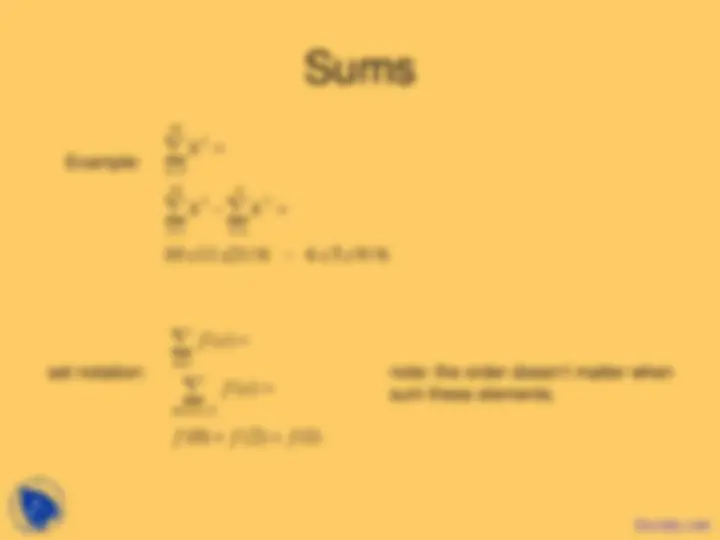
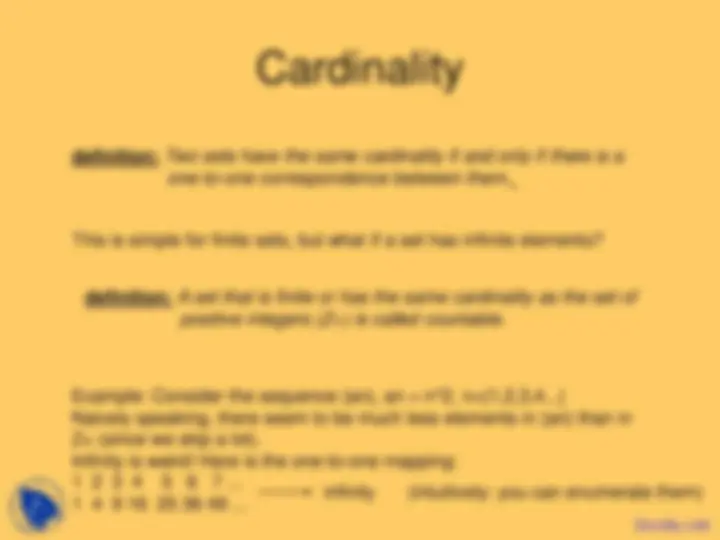
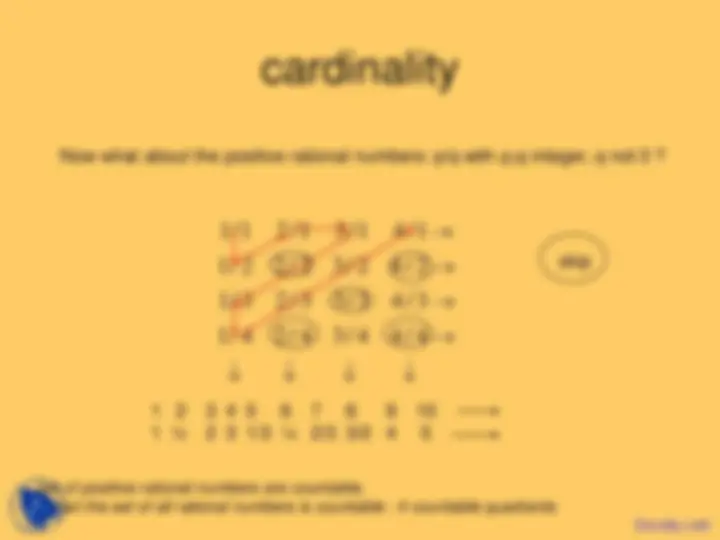
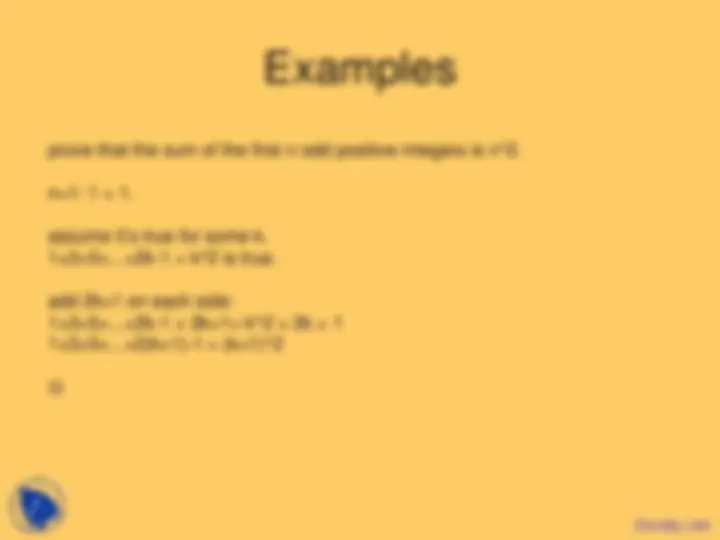
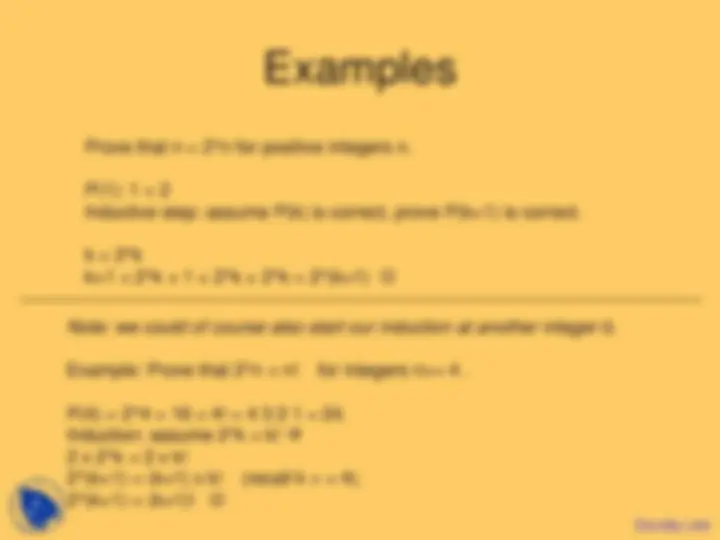
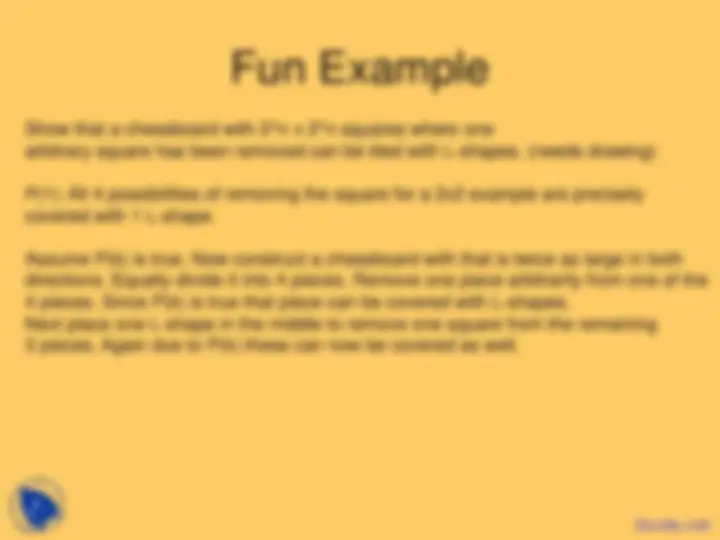
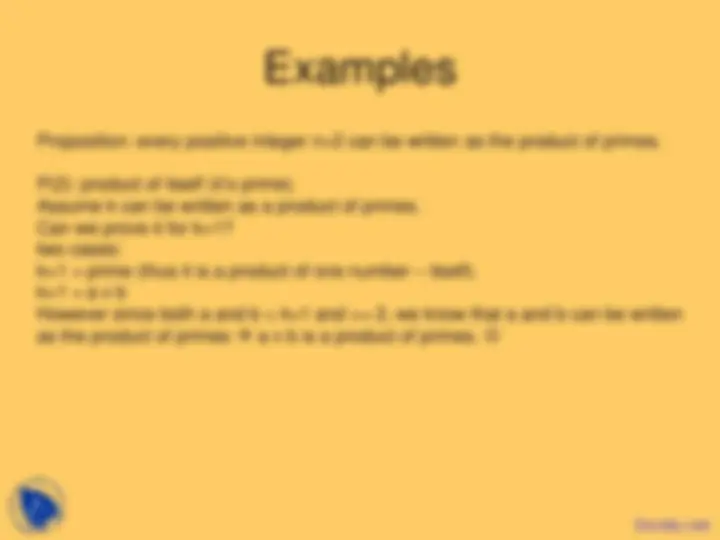
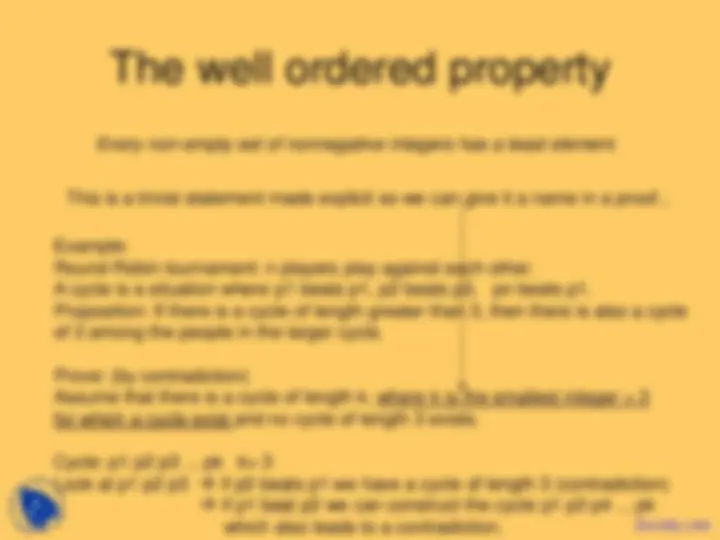
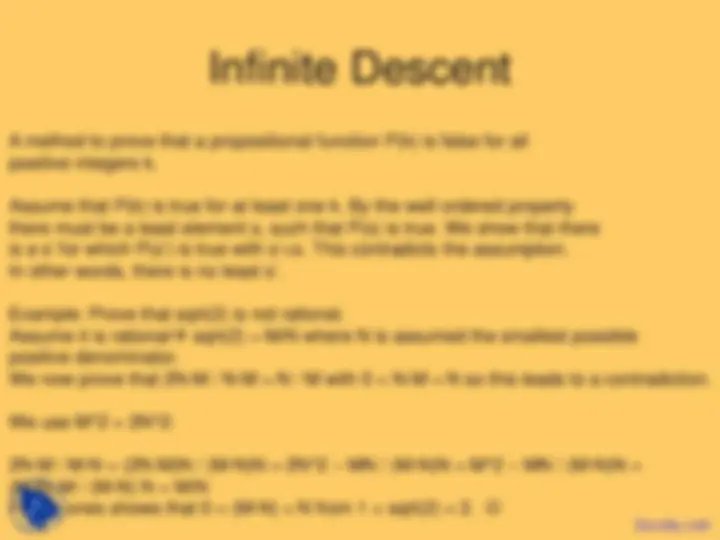


Study with the several resources on Docsity

Earn points by helping other students or get them with a premium plan


Prepare for your exams
Study with the several resources on Docsity

Earn points to download
Earn points by helping other students or get them with a premium plan
Community
Ask the community for help and clear up your study doubts
Discover the best universities in your country according to Docsity users
Free resources
Download our free guides on studying techniques, anxiety management strategies, and thesis advice from Docsity tutors
During the study of discrete mathematics, I found this course very informative and applicable.The main points in these lecture slides are:Sequences and Summations, Proof by Induction, Geometric Progression, Arithmetic Progression, Set Notation, Cardinality, Infinite Elements, One-To-One Mapping, Mathematical Induction, Strong Induction, Non-Empty Set
Typology: Slides
1 / 15

This page cannot be seen from the preview
Don't miss anything!










geometric progression:
arithmetic progression:
some other useful sums:
0
n j
=
1
0
n n j j
=
2 1 3 2 2 1
0 (^12) 1
( 1)(2 1) 6 ( 1) 4 (^1) | | 1 1 (^1) | | 1 (1 )
n k n k k k k k k n n^ n
k n^ n
x (^) x if x
kx (^) x if x
=
= ∞ = ∞ (^) − =
= +^ +
= +
= (^) − <
= (^) − <
derivative
a=1, n infinity
definition: Two sets have the same cardinality if and only if there is a one-to-one correspondence between them.
This is simple for finite sets, but what if a set has infinite elements?
definition: A set that is finite or has the same cardinality as the set of positive integers (Z+) is called countable.
Example: Consider the sequence {an}, an = n^2, n={1,2,3,4...} Naively speaking, there seem to be much less elements in {an} than in Z+ (since we skip a lot). Infinity is weird! Here is the one-to-one mapping: 1 2 3 4 5 6 7 ... 1 4 9 16 25 36 49 ... infinity^ (intuitively: you can enumerate them)
Now what about the positive rational numbers: p/q with p,q integer, q not 0?
1/1 2 /1 3 /1 4 / 1/ 2 2 / 2 3 / 2 4 / 2 1/ 3 2 / 3 3 / 3 4 / 3 1/ 4 2 / 4 3 / 4 4 / 4
→ → → → ↓ ↓ ↓ ↓ 1 2 3 4 5 6 7 8 9 10 1 ½ 2 3 1/3 ¼ 2/3 3/2 4 5
skip
set of positive rational numbers are countable, in fact the set of all rational numbers is countable : 4 countable quadrants.
If we want to prove propositions P(k) for all positive integers, we may use inductions.
First we prove: P(1) is true. Then we prove P(k) P(k+1).
So, is P(100) true? yes, use “modus ponens” 99 times.
P(1) P(1)P(2)
P(2) P(2)P(3)
P(3)
until P(100).
formally:
prove that the sum of the first n odd positive integers is n^2.
n=1: 1 = 1.
assume it’s true for some k. 1+3+5+...+2k-1 = k^2 is true.
add 2k+1 on each side: 1+3+5+...+2k-1 + 2k+1= k^2 + 2k + 1 1+3+5+...+2(k+1)-1 = (k+1)^
Show that a chessboard with 2^n x 2^n squares where one arbitrary square has been removed can be tiled with L-shapes. (needs drawing)
P(1): All 4 possibilities of removing the square for a 2x2 example are precisely covered with 1 L-shape.
Assume P(k) is true. Now construct a chessboard with that is twice as large in both directions. Equally divide it into 4 pieces. Remove one piece arbitrarily from one of the 4 pieces. Since P(k) is true that piece can be covered with L-shapes. Next place one L-shape in the middle to remove one square from the remaining 3 pieces. Again due to P(k) these can now be covered as well.
(1) ( ( ) ( 1)) (1) [( (1) (2)) ( (2) (3)) ...( ( ) ( 1))] (1) ( (1) (2)) ( (2) (3)) ...( ( ) ( 1)) (1) (2) ... ( ) ( ( ) ( 1)) (1) [ (1) (2) ... ( )] ( 1)
P k P k P k P k P P P P P k P k P P P P P P k P k arbitrary k P P P k P k P k arbitrary k P k P P P k P k
∧ ∀ → + → ∧ ∀ → ∧ → ∧ → + ∧ → ∧ → ∧ → + ∧ ∧ ∧ → + ∧ ∀ ∧ ∧ ∧ → +
induction (I):
strong induction (SI):
P P P k P k
they are equivalent
Proposition: every positive integer n>2 can be written as the product of primes.
P(2): product of itself (it’s prime). Assume k can be written as a product of primes. Can we prove it for k+1? two cases: k+1 = prime (thus it is a product of one number – itself). k+1 = a x b However since both a and b < k+1 and >= 2, we know that a and b can be written as the product of primes a x b is a product of primes.
Every non-empty set of nonnegative integers has a least element.
This is a trivial statement made explicit so we can give it a name in a proof...
Example: Round-Robin tournament: n players play against each other. A cycle is a situation where p1 beats p1, p2 beats p3, pn beats p1. Proposition: If there is a cycle of length greater than 3, then there is also a cycle of 3 among the people in the larger cycle.
Prove: (by contradiction) Assume that there is a cycle of length k, where k is the smallest integer > 3 for which a cycle exist and no cycle of length 3 exists.
Cycle: p1 p2 p3 ... pk k> 3 Look at p1 p2 p3 if p3 beats p1 we have a cycle of length 3 (contradiction) if p1 beat p3 we can construct the cycle p1 p3 p4 ... pk which also leads to a contradiction. Docsity.com